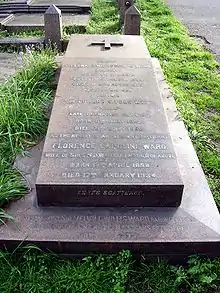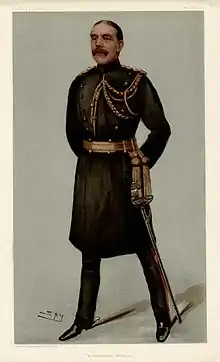Sir Edward Ward, 1st Baronet, of Wilbraham Place
Colonel Sir Edward Willis Duncan Ward, 1st Baronet GBE KCB KCVO (17 December 1853 – 11 September 1928) was a British Army officer and military administrator, serving as Permanent Secretary of the War Office. He was a notable reformer of army administration, improving efficiency of mobilization, medical services and supplies.

Sir Edward Ward | |
|---|---|
 "A Permanent Warrior". Caricature by Spy published in Vanity Fair in 1901. | |
| Born | Edward Willis Duncan Ward 17 December 1853 Oban, Scotland |
| Died | 11 September 1928 (aged 74) |
| Nationality | British |
Military career
Ward was born in Oban in 1853, the only son of Captain John Ward, RN, by his wife Mary Hope Bowie.[1] He was commissioned Sub-Lieutenant in the 2nd Royal Lanarkshire Militia in December 1873, and transferred to the 2nd West India Regiment in February 1874. In April 1874 he transferred into the Control Department as a Sub-Assistant Commissary, transferring to the new Commissariat and Transport Department in 1875, although he did not resign his militia commission until December 1874. He was promoted Assistant Commissary in 1876. In January 1880 the department changed its name to the Commissariat and Transport Staff and Ward became a Deputy Assistant Commissary-General in the new organisation.[1]
In April 1885 Commissariat and Transport Staff officers were given honorary military rank and Ward also became a Captain. He was with Sir Garnet Wolseley's sojourn up the Nile to recapture Khartoum. In December 1885 he was promoted to Assistant Commissary-General and Major. In December 1888 the department underwent yet another change, becoming the Army Service Corps, with its officers now holding full military rank. He was promoted Lieutenant-Colonel in June 1890. He went on the Ashanti Expedition in West Africa in 1895-6. Ward returned to England and was promoted to Brevet Colonel in March 1898.
Boer War
Ward sailed with the first ships to Cape Town Harbour in September 1899. After the Siege of Ladysmith, Sir George White called him 'the greatest supply officer since Moses'.[2]
In 1900 while on campaign he was appointed director of Supplies to the South African Field Force by Lord Roberts. Ward had begun life in the administration of military supplies. His organizational abilities were quickly discovered by after the chaotic state of affairs in 1899, the changes were most welcome. Lord Salisbury directed him to take up the position of Permanent Under-secretary at the War Office under Secretary St John Brodrick. A successful and competent civil servant Colonel Ward was elevated to a baronetcy of Wilbraham Place, in 1914 by the Liberal government overseeing the radical reforms of the Army Council. Ward could be credited, as his own publication revealed for founding the Army Service Corps; it played a decisive role in the BEF, keeping the logistics and transport departments supplied to the front.[3]
Ward was a President of the Union Jack Club,[4] and Chairman of the Royal Society for the Prevention of Cruelty to Animals. In 1919 he was appointed a Knight Grand Cross of the Order of the British Empire. During World War 1 he was also Director of the Camps Library, a charitable organisation which supplied books to troops and prisoners of war in France.[5]
Family
In 1880 he married Florence Caroline Simons (1858–1934).[6]
He was succeeded in the baronetcy by his eldest son, Captain Edward Simons Ward (1882–1930). Together with Frederick Hamilton-Temple-Blackwood, 3rd Marquess of Dufferin and Ava and Viscountess Ednam, he died when their aeroplane returning to London from Le Touquet exploded in midair over Meopham, Kent. Captain Ward was succeeded in the baronetcy by his younger brother, Melvill Willis Ward (1885–1973), as the 3rd Baronet. The title became extinct on his brother's death.
Decorations
- Companion of the Order of the Bath (CB) 1886
- Knight Commander of the Order of the Bath (KCB) 29 November 1900, in recognition of services in connection with the Campaign in South Africa 1899-1900[7]
- Knight Commander of the Royal Victorian Order (KCVO) 1907
- Knight Grand Cross of the Order of the British Empire (GBE) 1919
References
- Peter Grant (18 February 2014). Philanthropy and Voluntary Action in the First World War: Mobilizing Charity. Routledge. pp. 61–62. ISBN 978-1-134-50031-4.
- Late Sir Edward Ward. The Straits Times, 22 September 1928, Page 9
- Retrieved 22 July 2016.
- Death of Sir Edward Ward. The Straits Times, 12 September 1928, Page 8
- King, Edmund G. C. (2013). ""Books Are More to Me Than Food": British Prisoners of War as Readers, 1914-1918". Book History. 16: 246–271. ISSN 1098-7371.
- Arthur Charles Fox-Davies, Armorial families : a directory of gentlemen of coat-armour (Volume 2), ebook
- "No. 27306". The London Gazette. 19 April 1901. p. 2695.
External links
- Sir Edward's Inspection 1914 Retrieved on 22 July 2016.
- Knighthood 1914 Retrieved on 22 July 2016.
- Obituary Sir Edward Ward Retrieved 22 July 2016.
| Baronetage of the United Kingdom | ||
|---|---|---|
| New creation | Baronet (of Wilbraham Place) 1914–1928 |
Succeeded by Edward Simons Ward |